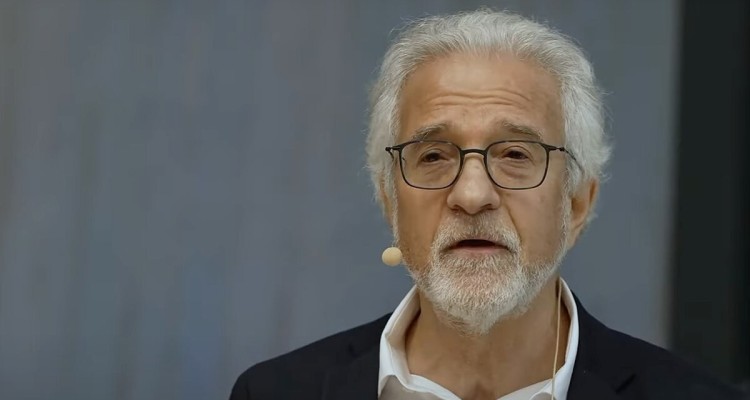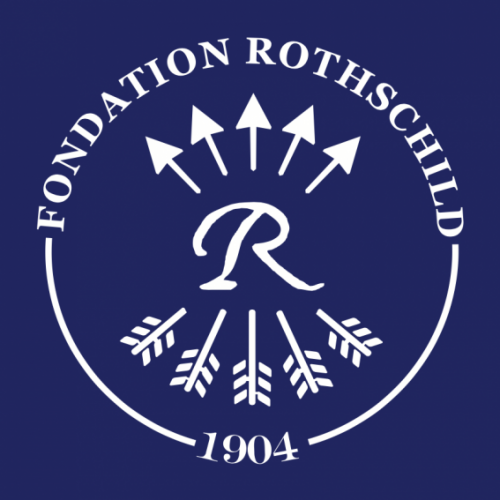In 1943, a Baedeker on the General Government of Poland was published. The famous tourist guide offered Germans a tour of the Polish outpost of the Eastern living space – also referred to by the Nazis as “Wilder Osten“, or the Wild East. Carol Fily immersed herself for K. in the book, which was designed at the time under the patronage of Hans Frank, the Governor General of Poland during the war.
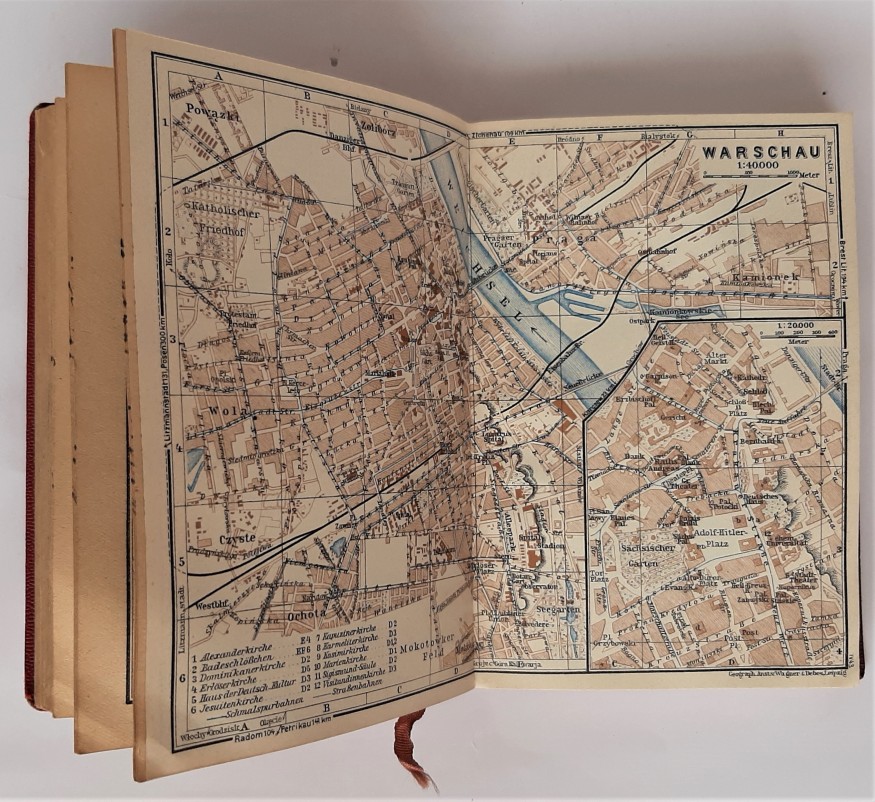
In 1943 a Baedeker on the General Government of Poland was published. With a few clicks on a well-known sales site, I placed my order, for about 100 euros. I would never have imagined myself capable of paying such a sum for such a thing, and on such a site. The thing in question arrived two days later. It was just like the pictures I saw on the Internet: red and gold cover, pocket size. So, the sentence I had read — and reread — in Timothy Snyder’s Bloodlands was not a hallucination: “The Warsaw Ghetto became a tourist attraction for visiting Germans. Ghetto historian Emmanuel Ringelblum observed that ‘the morgue in which the corpses to be buried during the night are deposited’ was very popular. The General Government’s Baedeker Guide was to appear in 1943.”
A Brief Historical Reminder
The Baedeker books are probably the most popular travel guides in the world. Born in Germany in the 1830s, when the rise of the steamboat and the railroad gave birth to modern travel, which was beginning to be called “tourism,” the works of the publisher Karl Baedeker (1801-1859) quickly imposed themselves against their foreign competitors (notably the Guides Joanne, ancestors of the Guides bleus). It must be said that in terms of precision and practical advice, they are unsurpassed, Karl Baedeker, then his descendants, used to go to the countries concerned to visit the monuments, evaluate restaurants and hotels, and to ensure the regular updating of information, thanks to a remarkable organization: for each title of the collection, a coordinator, assisted by specialists in different fields, is appointed. The Baedeker thus became the bible of the bourgeois traveler and was recognized in scholarly circles as a high-quality scientific source.
In 1900, the company already counted seventy titles in its catalog — including several editions in English and French — and some estimate that it could have, in the long run, covered the whole world had the war not broken out. The war not only brought a halt to the booming tourist business but also signaled the beginning of a dark period for the company, marked by the Great Depression, the rise of the Nazis to power in 1933, and the Second World War.
And yet, even in these troubled times, Baedekers keep being published as my own copy of the guide to the Polish General Government proves. The term “General Government” refers to the “General Government of Warsaw,[1]” a territory that came under Russian rule in 1867 and then German rule during the First World War. The name disappeared when Poland was created in 1918, but it resurfaced in October 1939 after the Nazis conquered the country which was the first victim of their policy of expansion in the East. The remaining territories, some 97,000 km2 populated by less than 1% of Germans (142,000 km2 with Galicia as annexed in August 1941), became the General Government, which Hitler entrusted to his former lawyer, Hans Frank, who was appointed Governor General of Poland for the occasion. The latter took up residence in the old royal castle of Krakow, chosen as the capital.

Administered by the Reich without being part of it, the General Government was a semi-colonial entity conceived as a reservoir of slave labor and raw materials that had to be exploited to the maximum for meeting the needs of the Reich. It was also intended to serve as a “dumping ground” for the Jews and other undesirables expelled from the annexed Polish territories, which were to be colonized by several million ethnic Germans (Volksdeutsche) previously scattered throughout Eastern Europe.
Although clearly defined on paper, this program was to run into difficulties in terms of its application, due to confused and contradictory policies. The General Government plunged into a state of chaos whose only outcome — after the failure of various plans to deport the Jews, the change in its status in 1941 (it was to become purely German within fifteen to twenty years), and the turning point of the war — was the systematic extermination of the Jews on the spot, starting in 1942 the very same year that the Baedeker was written.
But how to make a tourist guide about a territory that became in a few months the scene of one of the most atrocious events in history? A territory where the only things likely to evoke any form of travel are the convoys heading for its four killing centers, which are in full swing? A territory where the first images that come to mind are those of roundups, overcrowded and unhealthy ghettos (the General Government counts over 400 of them!), forced labor camps, crematoriums, mass graves?
Beyond the horror that such an aberration arouses, one should wonder about the reasons that could motivate an institution such as Baedeker to publish a 264-page guidebook on a region that looked more like hell than the promised tourist paradise, in an overall context not at all favorable to leisure travel[2].
An Occupation Tourism
Produced at the initiative of the Governor General himself, the Baedeker — consistent with its purpose — aims to introduce travelers to “the region and its inhabitants” as well as its “historical context,” but above all to “give them an idea of the extent of the organization and construction work that has been accomplished (or is still in progress).” Since the beginning of the occupation. Hans Baedeker — Karl’s grandson — could count on the help of his long-time partner, Oskar Steinheil, to carry out this mission, which he welcomed with “joy.” Invited by Hans Frank, Steinheil traveled throughout the country in the autumn of 1942, collecting information and documents from various authorities such as the Main Propaganda Division.
No doubt that this Baedeker is intended as a propaganda book, which is hardly surprising when one considers the guides issued by the publishing house since the Nazi takeover. The Nazis consider the Baedekers to be an “outstanding work of German culture” and thus one of their “most noble means of propaganda abroad.[3]” However, in contrast to the 1936 guide to Olympic Berlin, which was openly aimed at an international audience, the 1943 guide does not attempt to spread the image of the General Government beyond the borders of the Reich.
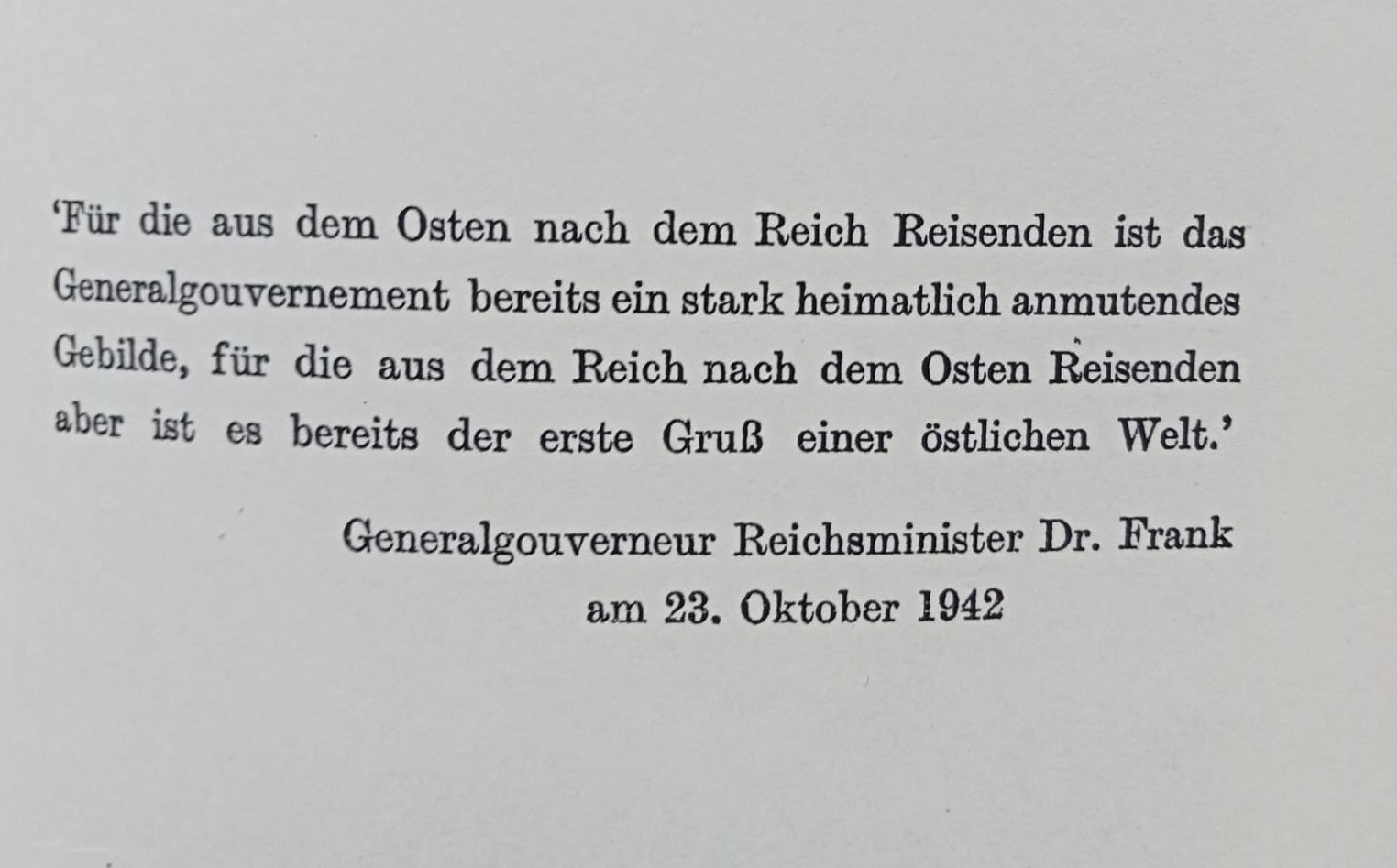
This image is the result of Hans Frank’s efforts to make this “Reich’s neighbor” a showcase for Nazi policies of conquest and occupation, although, on paper, it is not supposed to become so. But the Governor General, or “King Stanislaus,” as he was called by the Party leaders, was so fond of culture and pomp that he could not possibly confine himself to his role as a tyrant in charge of a reservoir of slaves and Jews.
He thus committed considerable expenses to enhance his fiefdom (and to promote himself) and to develop a German cultural life therein. Although weakened by the attacks of his rivals and the discrediting of his collaborators, he carries out numerous projects, ranging from the creation of an official newspaper to that of a literature prize, including the foundation of a philharmonic orchestra and scientific institutions such as the “Institute for German Work in the East” (Institut für Deutsche Ostarbeit). He proclaims himself chairman of the said Institute, two of whose members will also be among the “eminent experts” responsible for writing the introductory articles of the Baedeker.
Hans Frank suggests a print run of 20,000 copies, which, in a tense economic climate due to the war, represents an enormous amount of paper. However, it is difficult to estimate how many books were actually produced, distributed, and sold, as well as the number of actual readers and travelers, whose profiles are presented in the “Practical Information”: the guide is aimed at Reich officials and businessmen, as well as people wishing to visit a family member stationed in the General Government or to pay their respects in a “military cemetery.” In addition, the guide is intended for German soldiers and civilians occupying the region.
The war did not put an end to tourism. It simply changed the modalities, giving birth to what could be called “occupation tourism.” However, this activity is selective since not everyone can enter the territory as demonstrated by the number of documents that must be presented to cross the border. Unlike in Alsace, about which there was also a Baedeker published in 1942, traveling in the General Government indeed amounts indeed to entering a “foreign” country. Not so foreign, given the already advanced Germanization of the Polish territory…
A Destination to Suit all Tastes
How can one resist the enticing journey to which the epigraph, written by Hans Frank himself, invites the reader? “For those who reach the Reich from the east, the General Government is an entity with very familiar overtones, for those who travel east from the Reich, it is the first greeting of an oriental world.” The General Government, a destination where the familiar meets the exotic. The ideal combination, isn’t it?
Just like Hans Frank’s liminary formula, the content of the guide is, worthy of an advertising slogan. The General Government had indeed everything to please, the Baedeker describing it as an area with a varied landscape where there was no shortage of opportunities for sport, culture, entertainment, and relaxation.
Even medium-sized towns have theaters with German-language performances (there are even theaters reserved for soldiers and the SS), cinemas showing German films, cabarets, German libraries and bookstores, and concert halls. You would have to be very picky not to find what you are looking for, especially since the guide gives good advice: if you want to go to the movies in the evening, buy your tickets in advance because of the large number of people; in the bars, look at the prices posted before ordering, just as you should ask about the prices before getting into a cab in Krakow. In other words: beware of scams! A master must always be wary of his slaves. Also, there is nothing better than the inbreeding, which is fostered in the many “German inns,” arranged in an “exemplary” manner, as well as in the “German houses,” places of conviviality serving as a substitute home for Germans passing through or settled in permanently. Non-German restaurants should be avoided, except for those marked “Authorized for Wehrmacht and Germans.”
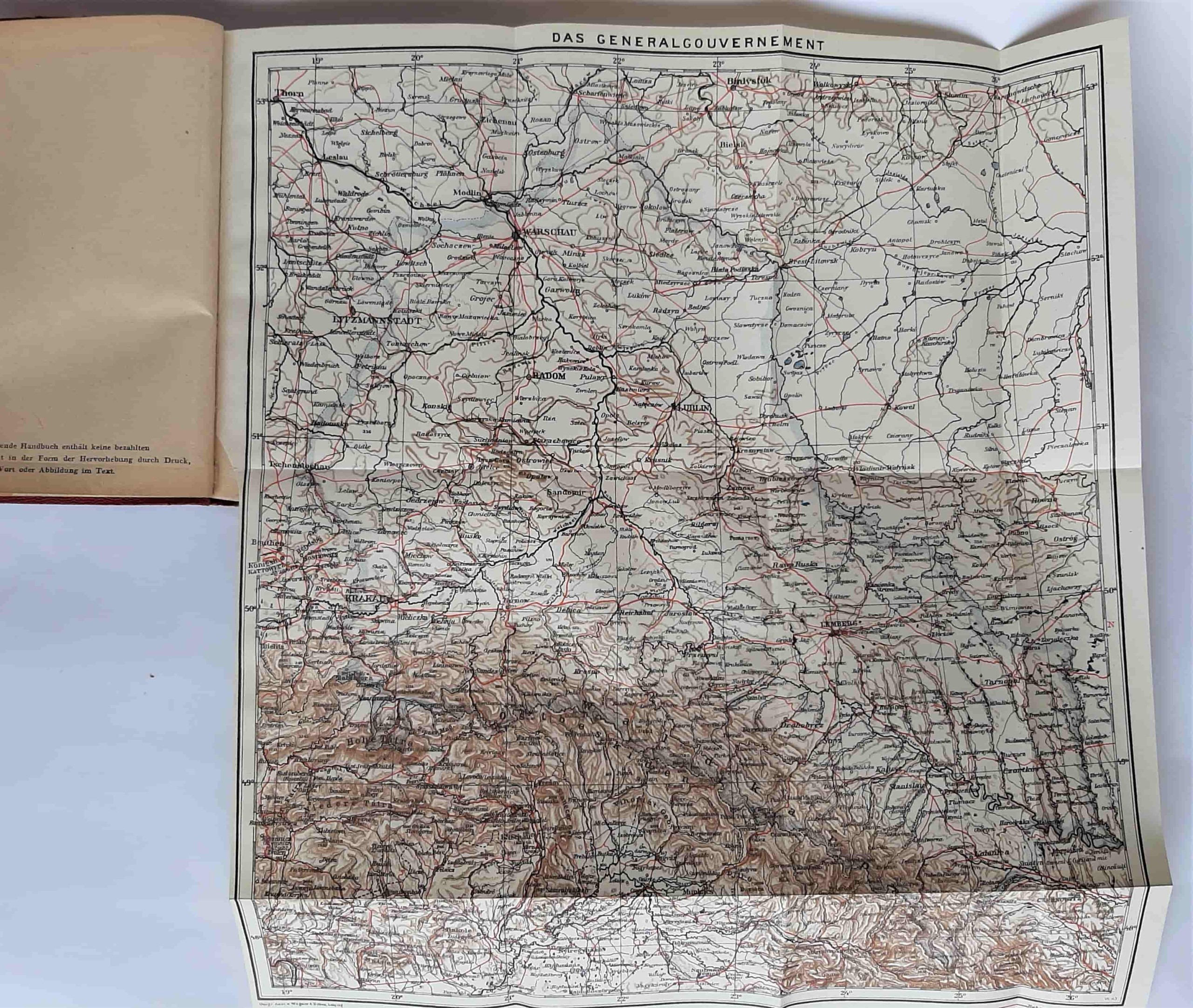
Art and architecture lovers will discover gems from different periods, from Romanesque to Modern, including Neoclassical and Italian Renaissance. All these works — creations of German artists — contribute to the charm of the cities, which are themselves German, the guide systematically repeating that they were founded in the Middle Ages under the “urban law of Magdeburg.” The later is indeed supposed to have played a decisive role in their configuration, still visible in 1942, especially through their large square plazas, the most beautiful of which is the one in Krakow, the symbol of Germanness par excellence.
Beyond their aesthetic interest, these elements can thus be perceived as “witnesses” to the “extraordinary civilizing work” accomplished in the East by the Germans for nearly a thousand years within the framework of the “German settlement in the East.” The latter is a key feature of German history and should be remembered as one of the arguments on which Hitler based his expansionist policy. By conquering Poland in 1939, Germany was simply taking back what was rightfully theirs: a German space for centuries, millennia even, if we are to believe the guidebook, which, relaying the scientific discourse of the time, reminds us that the presence of Germanic populations in the “country of the Vistula” goes back to prehistoric times. This presence is allegedly attested by archaeological evidence, the Nazis being masters in the art of invoking science to provide a pseudo-scientific aspect to their ideology.
It is also possible to practice all kinds of sports (through German associations, of course), including skiing. For example, to get to the slopes of Zakopane, a popular resort in the High Tatras, you can take an express train from Krakow. The guidebook specifies that the General Government has a quality railway network, the Ostbahn, created as a result of the reconstruction, carried out in a “short period of time,” of the infrastructure of former Poland, which was largely destroyed in 1939 and 1941. On the other hand, motorized travelers can take one of the many roads that crisscross the territory and were also renovated thanks to quality work and, like in the Reich, marked with international signs.
For those who are looking for rest and relaxation, the General Government offers a wide range of climatic resorts, most of which are also located in the Carpathians, have thermal facilities where various ailments are treated with water of all kinds or mud and peat baths. There is nothing like this to restore the strength of a brave soldier or SS officer who is aching after a tough week. The effort has to be followed by comfort. And, on top of that, a good night’s sleep in a first-class hotel run, of course, by Germans…
For any health concerns, you can also count on the presence of German pharmacies, doctors, and hospitals. And for any information, go to the Tourist Office of the General Government, to the local tourist offices, to the Propaganda Division, or to the local sections of the NSDAP.
An Outpost of the “New Order”
Familiar in many ways, the General Government is much less so in others. The further you go into its confines, the more you move towards the famous “East” mentioned by Frank, and the more the space takes on exotic, even wild, notes.
Its climate, “mild,” even “warm” and “Mediterranean,” is conducive to the development of “abundant vegetation” and the cultivation of apricots, peaches, almonds, and even melons, as well as the landscapes, are already reminiscent of the Balkans.
These remote regions are, moreover, the land of choice of tribes with shimmering names, Lemkos, Boïkos, Houtsoules. The Baedeker qualifies the latter as “interesting from an ethnological point of view” and, deviating from his usual sobriety, dedicates a long paragraph to them where he presents their “picturesque costumes” and traditions kept “intact” because of their “geographical isolation.” The guidebook then reports on a “folklife” high in colors that unfolds in some villages on feast days and markets.
This description, as touristy as one could wish, calls for another reading. How, in fact, can we not see in this valiant people, close to nature and untouched by any alteration from outside, a reminiscence of the original Germanic people, a model that lies at the heart of the Nazi program of racial regeneration? And how can we not see the General Government as the prelude to that lost paradise that Hitler aspires to restore to his people?
Thus portrayed, the General Government has all the appearance of the “Germanic Garden of Eden” that Hitler wished to confer on the conquered eastern territories. It is presented as an entirely German space, structured by the Germans for the Germans, like an extension of their Heimat. A totally controlled and mastered space, as evidenced by the Germanization of place names or the precision of the information on railroad connections, accommodation possibilities, and administrative organization. A fine example of successful colonization – hats off to Dr. Frank.

This omnipresence of the Germanic element is also reflected in the abundance of vestiges of German culture that the guidebook reveals along the itineraries and in the cities that it takes the visitor through. By inscribing the tourist development of the General Government in the natural continuity of the civilizing mission of the Germans in the East, the book establishes a link between the past, the present, and the future: “Tourism has a great future ahead of it.” This “great future” seems limitless, just like the space in which it must be realized, that of the “new order” in Europe sought by the Nazis and of which Hans Frank’s stronghold — “a link between the front and the homeland” — is presented as the outpost. The past, present, and future seem to be one and the same; the universe described page after page appears to be out of history as if it had entered a new era, that of the Nazi utopia, of which the guidebook is both the concrete and symbolic projection. In brief, the Boedecker aims “to return to this country of the Vistula German individuals and a Germanic identity, in all senses of the term!”
However, there are some shadows in this idyllic picture. If the territory is no longer a war zone in the strict sense, it remains an ever-present reality in 1942, especially in Galicia, where much damage has not yet been repaired. Moreover, the guidebook reminds us that in “wartime,” it is impossible to guarantee “the absolute accuracy of each data.” Whether it’s the price of food or transportation schedules, everything can change at any time in this territory. Indeed, one may find, here and there, signs of precariousness detectable in the advice given to motorized visitors, such as bringing spare cans because of the shortage of gas stations, or carrying a weapon if you travel at night. This is more of a warning. Danger lurks around since Germans are in the doghouse everywhere.
Being relatively few in number and usually cited in parentheses, these “negative” elements appear insignificant, if not non-existent, in view not only of the impression of perfect mastery that emanates from the space described, but also of all its wealth, Germanness, and natural beauty – often gratified with one or two stars. Here, everything seems “beautiful,” “charming,” “magnificent” or simply “to be seen.” Above all, everything seems normal.
“Build,” “renovate,” “develop,” “arrange,” “populate.” These are the keywords that have guided the actions of the Germans since October 1939. However, if there is not a page where the Baedeker does not mention the results of this creative work, nothing is revealed about the means of its realization. This is a wise move: it would detract from the impression of harmony that emanates from the entire work. And for good reason: to imprint their identity on the territory, to create something new in their image, the Germans had to destroy what existed – to Germanize “in every sense of the word.” Select, classify, and order. Isn’t that, in the end, what all travel guides do? In order to show what is “important,” don’t they have to eliminate what is not worthy of being seen? Using a subtle mix between visible and invisible, they incite the traveler to see the reality arranged in a specific order. What do they do then, if not display “a vision of the world,” as Freud wrote in 1926 about the Baedekers[4]?
It is easy to understand, when reading this Baedeker, why the Nazis considered these guidebooks as an ideal instrument for spreading their Weltanschauung [worldview]. But what the one at issue does not say — its silences, which are part of its essence — does deserve attention too. Also, by penetrating the other side of his decor, one discovers other, even more, disturbing intents.
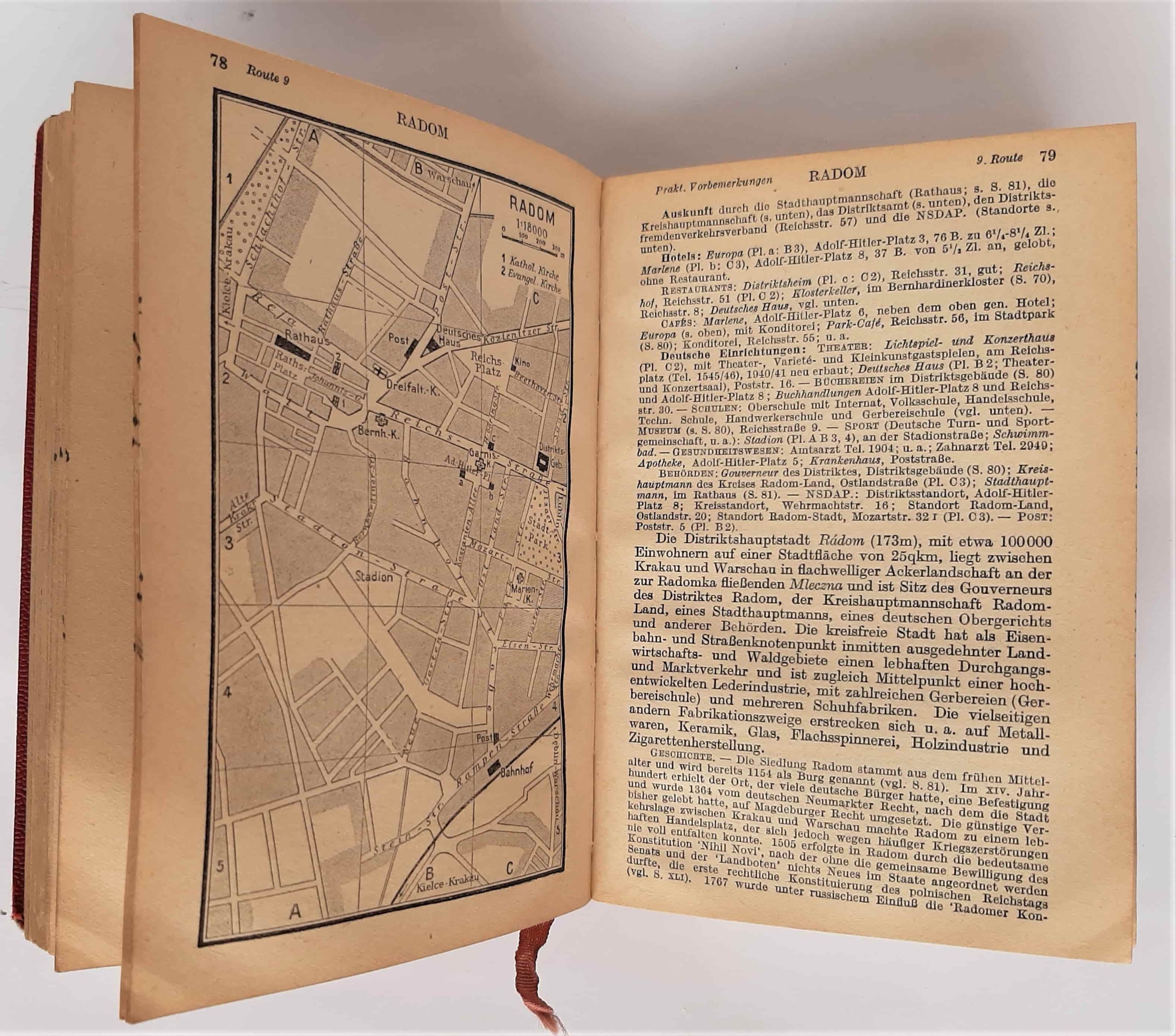
History trickery
The guidebook, in reporting on German “achievements,” actually exalts the triumph of Germanness in the East – even if much remains to be done. Each line can thus be read as proof of the superiority of the Germanic race. Where, however, no reference points to German history and culture can be detected, it gives pride of place to Nazi institutions, the aim being undoubtedly to assert, through this strategy of accumulation, the power of the regime’s administrative apparatus.
Now, who says superiority of some says inferiority of others: the Poles, in this case, gratified here and there with a devaluing remark, echo of well-anchored stereotypes. The guidebook particularly points out their “cultural backwardness” and the way they have “disfigured” the landscapes as a result of their “character” and their “race” as well as “a way of apprehending existence that is totally foreign to the Germans.” Too foreign, too boorish, the native population is thus presented as a gaggle that it is better not to mix with. One can thus guess why the guidebook advises against “non-German” restaurants and points out the existence of train cars or streetcars reserved for Germans.
Victims of prejudice, the Poles are just as well victims of silence. The chapter “History of Art” provides a good example: although the author, Dagobert Frey, does not omit to mention Polish historical monuments, his descriptions, full of German names, convey the impression that “Old Poland” owes very little to the Poles. The rare Polish artists he mentions are only described, with a few exceptions, as mere “disciples.” Yet it is difficult to apply such a term to a renowned scientist such as Nicolaus Copernicus. This is why he became a “great German astronomer.” How can one not see in this rhetoric of erasure and usurpation an allusion to the policies put in place by Hans Frank to suppress the “Polish principle” in all its forms?Between the massacre and deportation of the elite, the closing of universities (the guidebook mentions the “ancient” University of Krakow), and the looting of works of art (the reason, indeed, why “most of the museums and collections were closed during the war”?), King Stanislaus did not skimp on the means to make the General Government a cultural desert, which is visible even in the names of its streets and places. To create Adolf Hitler squares, Göring or Heydrich streets, etc., it was indeed necessary to erase Sobieski, Sienkiewicz, or Pilsudski. And, of course, Ludwig Zamenhof who, before being the inventor of Esperanto, was above all Jewish.
And the Jews in all this? The Jews – those we think of spontaneously when we first see the guide, and the first word we are tempted to look for. This word appears 34 times – not very many compared to the innumerable “beautiful” and “charming,” but enough to understand its function in the economy of the text[5].
The “Jews” appear exclusively in the historical summary preceding the descriptions of some twenty cities. They are portrayed, in more or less veiled terms, as an invasive population, greedy for power and money (“they […] took over the capital market and the trade”) which not only usurped the place of Germans during the Polish takeover of the territory (in the sixteenth and seventeenth centuries) but also led to the decline of the cities involved. However, since their “return to German administration,” these cities have become “clean” again and are experiencing a “new boom.” What can we conclude from these remarks, except that the Jews proved to be a good opportunity, a pretext even, to restore the territory to its golden age? But what happened to them? Krakow and Lublin are “(now judenfrei)” — in parentheses, sic — and the Jews of Kazimierz were “moved” before the implementation, in 1940, of a development program aimed at transforming the city into a “pleasant resort for the Germans.” Beyond that, there is silence. The Jews present in the text are in fact absent figures, erased from the map and erased from history. The proof is the population figures of the General Government in 1942, of which Baedeker proposes the following breakdown: “72% Poles, 17% Ukrainians (Ruthenians), 0.7% Germans.”
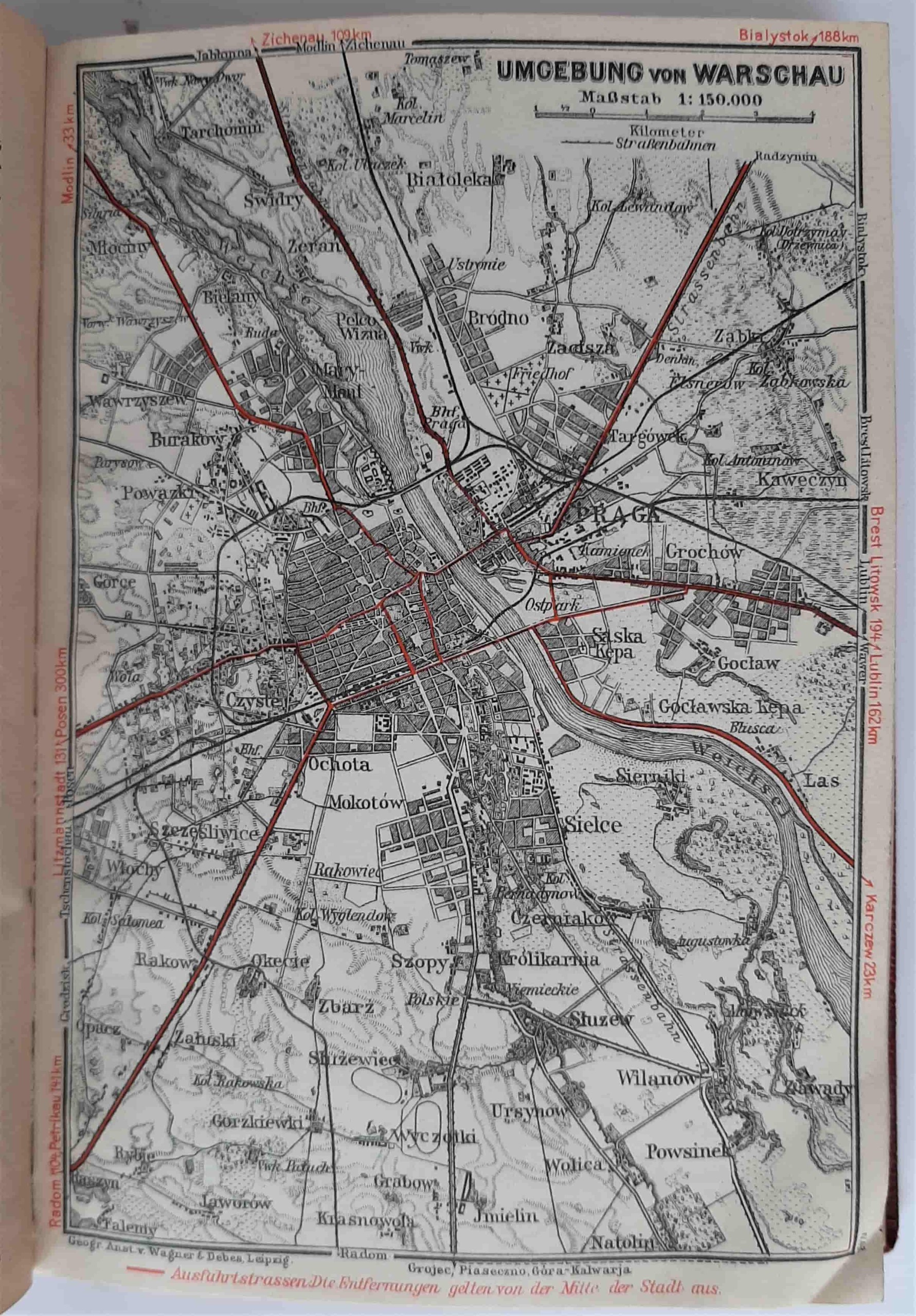
In other words, 10.3% of the population (i.e., 1.8 million) were missing[6].
This fact is as troubling as it is illustrative of the cynicism that shines throughout the text, on its surface as well as in its underpinnings, in a subtle interplay between unveiling and concealment. The guidebook does not mention the slightest monument recalling the secular history of the Jews in the territory: not a single synagogue, not a single cemetery appears in the descriptions or on the maps of the cities, the one in Krakow being materialized by a white spot, a blank. The only evidence of this bygone Jewish life is the “Lublin Talmudic School” and the numbers or percentages of Jews who lived in the cities (57% of Jews in Lublin in 1852). There is no mention of any evidence of the presence of Jews, although there are still many of them alive at the time of writing in 1942. No word, for example, about the Warsaw ghetto, which at that time still numbered 350,000 people, while its nearby surroundings are the subject of attractive descriptions, such as the Brühl and Krasinski Palaces (decorated with a star) or the Saxon Garden, a “beautiful public park” that “attracts a large number of visitors,” with its “old trees” and “water tower in the shape of an ancient temple.”
Snyder’s sentence as quoted at the beginning of the article — the very one that aroused my curiosity and provoked my desire to get the guidebook — takes, upon reading it, a strange and even fallacious turn.” The Warsaw ghetto became a tourist attraction for visiting Germans,” the historian writes, immediately citing the publication of the Baedeker and implying that the persecution of the Jews could become, “for visiting Germans,” an attraction to visit. One wonders what source the historian relied on to infuse such an idea. A review of the works on the Warsaw ghetto suggests that, although Nazi administrators and German soldiers were able to enter the ghetto, it was by no means a place for “tourists.”
Between the unspoken, suggestive terseness and the accumulation of aesthetic elements with Germanic accents (“the humanity of the country disappears to the exclusive benefit of its monuments[7]”), the Baedeker thus mobilizes a whole range of rhetorical procedures to mask and erase any Jewish presence in the General Government, while revealing in hollow the process of its erasure, which is then in full swing. However, this process is not described as such: nothing is said about the machinery of the Shoah.
Auschwitz is simply an “industrial town of 12,000 inhabitants, the former capital of the duchies of Auschwitz and Zator,” connected to Kraków by “a secondary railroad line.” Of Bełżec there is mention only of the “train station,” where one can take a bus to Tomaszów Lubelski, a charming town “surrounded by lakes and wooded heights” where one can find “a beautiful wooden Baroque church dating from the eighteenth century.”
Underneath its classical look reminiscent of its pre-war predecessors, the Baedeker published in 1943 turns out to be an anomaly among “its own.” Filled with information that is three-quarters useless — most of the hotels had been requisitioned to house soldiers, war invalids, or forced laborers —, this guide is above all intended for a fictitious traveler to whom it offers an enlightening representation of the program of conquest and colonization carried out by the Nazis while concealing its criminal aspects: the erasure of places of memory and “undesirable” populations in favor of the masterful narrative of the German civilizing work and its “great future,” prefigured by the tourist development of the General Government described page after page.
However, this future did not come to pass. Conquered by the Red Army in 1944, the General Government was dissolved in January 1945; Hans Frank, the “Butcher of Poland,” was tried and hanged in Nuremberg in October 1946. The Baedeker thus loses all reason to exist and falls into the oblivion of the house which, sometime after the war, resumes its publications as if nothing had happened. This attitude of denial, shared by most German publishers, is symptomatic of the process of collective repression of the past that took place in West Germany in the 1950s.
Among the editors of our 1943 Baedeker, Oskar Steinheil, a hardcore Nazi, best known for his 1938 automobile guide, continued to work in this field until his death in 1971. In 1948, a nephew of Hans Baedeker founded a new company that published guides to German regions and cities. The art historian Dagobert Frey, among others, was awarded a professorship at the University of Stuttgart in 1951. Did his students at the time know that he had not only written a chapter of the guide but also actively participated in the looting of works of art in the occupied territories of Poland?
Carole Fily
Carole Fily is a Germanist and translator from German.
Translated from French by Bernard Dov Belz
Notes
| 1 | The complete name is “General Governorate for the Occupied Polish Region” [Generalgouvernement für die besetzten polnischen Gebiete]. |
| 2 | On tourism under Nazism, cf: Götz Aly and Susanne Heim, Vordenker der Vernichtung. Auschwitz und die deutschen Pläne für eine neue europäische Ordnung, Frankfurt/M., 1993, pp. 188-91; Rudy Koshar, German Travel Cultures, Oxford, 2000, pp. 153-59; Nicholas Lane, “Tourism in Nazi-Occupied Poland: Baedeker’s General-gouvernement”, East European Jewish Affairs, vol. 27, no. 1 (1997), pp. 45-56; Peter J. Brenner, “Schwierige Reisen. Wandlungen des Reiseberichts in Deutschland 1918-1945,” in Reisekultur in Deutschland, edited by Peter J. Brenner, Berlin, Boston, Max Niemeyer Verlag, 1997, pp. 127-176; Kristin Semmens, Seeing Hitler’s Germany. Tourism in the Third Reich, Houndmills, 2005, pp. 172-73; Susanne Müller, Die Welt des Baedeker. Eine Medienkulturgeschichte des Reiseführers 1830-1945, Frankfurt/M. and New York, 2012; Jane Caplan, “Jetzt judenfrei.” Writing tourism in Nazi-Occupied Poland, German Historical Institute, London, 2013; Martin Winstone, The Dark Heart of Hitler’s Europe: Nazi Rule in Poland under the General Government, London, 2014. |
| 3 | Peter und Monika Baumgarten, Baedeker, Ein Name wird zur Weltmarke. Die Geschichte des Verlages., Karl Baedeker, Ostfildern 1998, p.54. |
| 4 | “I must confess that I am not at all partial to the fabrication of Weltanschaungen. Such activities may be left to philosophers, who avowedly find it impossible to make their journey through life with a Baedeker of that kind to give them information on every subject. […] even the most up-to-date of them are nothing but attempts to find a substitute for the ancient, useful and all-sufficient Church Catechism.” In The standard edition of the complete psychological works of Sigmund Freud as translated by James Strachey, vol. XX, The Hogarth Press, London, 1959, p. 96. |
| 5 | See Jane Caplan, “Jetzt judenfrei.” Writing tourism in Nazi-Occupied Poland, German Historical Institute, London, 2013, 62 pages. In her study of the guidebook, the British historian focuses on the references made to Jews in the text |
| 6 | The figures do not reflect the reality but clearly illustrate the genocidal process at work. |
| 7 | Roland Barthes about the “Guide bleue” in Mythologies. |


